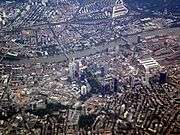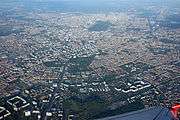Metropolitan regions in Germany

The metropolitan regions in Germany are eleven[1] densely populated areas in the Federal Republic of Germany. They comprise the major German cities and their surrounding catchment areas and form the political, commercial and cultural centres of the country. The eleven metropolitan regions in Germany were organised into political units for planning purposes.
Using a narrower definition of metropolises, only four cities surpass the threshold of at least one million inhabitants within its administrative borders, namely: Berlin, Hamburg, Munich and Cologne.
For urban centres outside metropolitan areas, that generate a similar attraction at smaller scale for their region, the concept of the Regiopolis and respectively regiopolitan area or regio was introduced by German professors in 2006.[2]
Metropolitan regions
Sorted alphabetically:
- Berlin Metropolitan Region
- Bremen/Oldenburg Metropolitan Region
- Central German Metropolitan Region
- Frankfurt/Rhine-Main Metropolitan Region
- Hamburg Metropolitan Region
- Hannover-Braunschweig-Göttingen-Wolfsburg Metropolitan Region
- Munich Metropolitan Region
- Nuremberg Metropolitan Region
- Rhine-Neckar Metropolitan Region
- Rhine-Ruhr Metropolitan Region (also covers the Cologne Bonn Region)
- Stuttgart Metropolitan Region
Big five
The five most important regions, collectively often called the "Big Five",[3][4] are frequently compared with other European metropolitan areas for investments and market development.[5] They are (from north to south): Hamburg, Berlin, Düsseldorf/Cologne (or collectively Rhine-Ruhr), Frankfurt/Rhine-Main and Munich. Globalization and World Cities Study Group (GaWC) considers Frankfurt and Munich "α" (Alpha) Global Cities, while the others are considered "β" (Beta) global cities.[6]
|
Each of them forms types of clusters and achieves varying levels of performance in areas such as business activity, human capital, information and technology exchange, cultural experience, and political engagement.[7]
- Frankfurt/Rhine-Main, for its financial economy and human transport
- Berlin, for its political and cultural importance
- Hamburg, for its importance in global logistics
- Munich, for its business, science and technology community
- Düsseldorf/Cologne/Rhine-Ruhr, for its logistics, technology and industry
List
| rank | metropolitan region (EMR) | core cities | states | population as by EMR[8] (2006) | population as by ESPON[9] (2007) | GDP per capita in €[10] (2006) | GMP in Billion €[8] (2006) | HQs of MNC (FG500[11]) | annual passenger traffic |
|---|---|---|---|---|---|---|---|---|---|
| 1 | Rhine-Ruhr EMR | K, DO, D, E, DU | NW | 11.47 million | 12.19 million | 29,486 | 338.21 | 13 | 30.80 million |
| Ruhr | DO, E, DU, BO | 5.26 million | 5.38 million | 25,266 | 132.90 | 4 | 2.30 million (DTM) | ||
| Düsseldorf | D, W, MG | 3.12 million | 3.07 million | 34,658 | 108.13 | 5 | 18.15 million (DUS) | ||
| Cologne/Bonn | K, BN | 3.09 million | 3.07 million | 31,448 | 97.18 | 4 | 10.35 million (CGN) | ||
| 2 | Berlin/Brandenburg EMR | B, P | BE, BR | 5.95 million | 4.02 million | 21,981 | 130.78 | 1 | 21.40 million (TXL, SXF) |
| 3 | Frankfurt/Rhine-Main EMR | F, WI, MZ, DA, OF, HU | HE, RP, BY | 5.52 million | 4.15 million | 35,000 | 193.20 | 4 | 57.44 million (FRA, HHN) |
| 4 | Stuttgart EMR | S, RT, ES, HN | BW | 5.29 million | N/A | 31,909 | 168.80 | 3[12] | 9.93 million |
| Stuttgart | S, ES | 2.67 million | 2.67 million | 35,492 | 94.76 | 3[13] | 9.93 million[14] (STR) | ||
| 5 | Munich EMR | M, A, (IN) | BY | 5.20 million | 3.27 million | 39,155 | 203.61 | 7 | 34.73 million |
| Munich[15] | M, FS | 2.59 million[16] | 2.67 million | 47,943 | 124.35[16] | 7 | 34.73 million (MUC) | ||
| 6 | Central German EMR | L, DD, C, HAL, EF | SN, ST, TH | 4.36 million | N/A | 21,482 | 93.66 | 0 | 4.88 million |
| Leipzig/Halle | L, HAL | 1.50 million | 1.21 million | no data | no data | 0 | 2.46 million (LEJ) | ||
| Dresden | DD | 0.70 million[17] | 0.88 million | no data | no data | 0 | 1.86 million (DRS) | ||
| 7 | Hamburg EMR | HH | HH, SH, NI | 4.27 million | 2.98 million | 33,210 | 141.81 | 2 | 12.84 million (HAM) |
| 8 | Hannover-Braunschweig- Göttingen-Wolfsburg EMR | H, BS, GÖ, WOB, SZ, HI | NI | 3.91 million | N/A | 27,251 | 106.55 | 3 | 5.74 million |
| Braunschweig/Wolfsburg | BS, WOB, SZ | 1.00 million[18] | 1.00 million | no data | no data | 1 | 0.10 million (BWE) | ||
| Hannover | H | 1.12 million* | 1.00 million | no data | no data | 2 | 5.64 million[19] (HAJ) | ||
| 9 | Nuremberg EMR | N, WÜ, FÜ, ER, BT, BA | BY | 3.51 million | 1.58 million | 29,955 | 105.14 | 0 | 4.27 million[20] (NUE) |
| 10 | Bremen/Oldenburg EMR | HB, OL, HBx, DEL, WHV | HB, NI | 2.37 million | 1.08 million | 27,046 | 64.10 | 0 | 2.49 million (BRE) |
| 11 | Rhine-Neckar EMR | MA, LU, HD, WO | BW, RP, HE | 2.36 million | 2.93 million | 29,891 | 70.54 | 1 | 0 |
| metropolitan regions in Germany | 57.74 million | 29,412 | 1,698.23 | 34 | 168.75 million | ||||
| Germany | 80.22 million | 28,212 | 2,322.20 | 37 | 191.02 million[21] |
highest score of all metropolitan regions
highest score of all metropolitan areas
See also
- Largest European metropolitan areas
- Largest urban areas of the European Union
- Demographics of Germany
- Tourism in Germany
References
- ↑ Mitglieder Retrieved 12 June 2009.
- ↑ Prof. Dr. Iris Reuther (FG Stadt- und Regionalplanung, Universität Kassel): Presentation "Regiopole Rostock". 11 December 2008, retrieved 13 June 2009 (PDF).
- ↑ Hans Heinrich Blotevogel. (PDF) (in German) //web.archive.org/web/20100602092219/http://cdl.niedersachsen.de/blob/images/C18102984_L20.pdf. Archived from the original (PDF) on 2 June 2010. Retrieved 14 February 2011. Missing or empty
|title=(help) - ↑ Dr. Radetzki Consult GmbH (PDF) Retrieved 14 February 2011.
- ↑ "C&W European Cities Monitor 2008: London, Paris and Frankfurt the best business locations in Europe". Archived from the original on 8 July 2011. Retrieved 14 February 2011.
- ↑ The World According to GaWC 2010 Retrieved 14 February 2011.
- ↑ "Positionierung Europäischer Metropolregionen in Deutschland, Metropolfunktionen in Metropolregionen" (PDF). Bundesamt für Bauwesen und Raumordnung. 2009. p. 3. Retrieved 14 February 2011.
- 1 2 Regionales Monitoring 2008 - Daten und Karten zu den Europäischen Metropolregionen (EMR) in Deutschland (PDF) Retrieved 22 June 2009.
- ↑ "ESPON project 1.4.3: Study on Urban Functions: Final Report" (PDF). Retrieved 22 June 2009.
- ↑ Regionales Monitoring 2008 - Daten und Karten zu den Europäischen Metropolregionen (EMR) in Deutschland
- ↑ Global 500 CNNMoney Retrieved 22 June 2009.
- ↑ Retrieved 03 November 2015: Daimler, Bosch, LBBW
- ↑ Retrieved 03 November 2015: Daimler, Bosch, LBBW
- ↑ Wichtige Kennziffern der Flughafen Stuttgart GmbH Retrieved 22 June 2009.
- ↑ http://www.region-muenchen.com/ Retrieved 25 June 2009.
- 1 2 "Region München 2006 Regionaler Planungsverband München" (PDF). Archived from the original (PDF) on 19 July 2011. Retrieved 25 June 2009.
- ↑ "Bevölkerungsbilanz in der Stadt-Umland-Region". Archived from the original on 9 February 2009. Retrieved 22 June 2009.
- ↑ "Das Tätigkeitsgebiet: Die Region Braunschweig". Archived from the original on 2 June 2009. Retrieved 22 June 2009.
- ↑ http://www.hannover-airport.de/189.html Retrieved 22 June 2009. Archived October 30, 2007, at the Wayback Machine.
- ↑ "Airport Nurnberg". Archived from the original on 12 June 2009. Retrieved 22 June 2009.
- ↑ ADV Monatsstatistik / ADV Monthly Traffic Statistics (PDF) Retrieved 22 June 2009.





